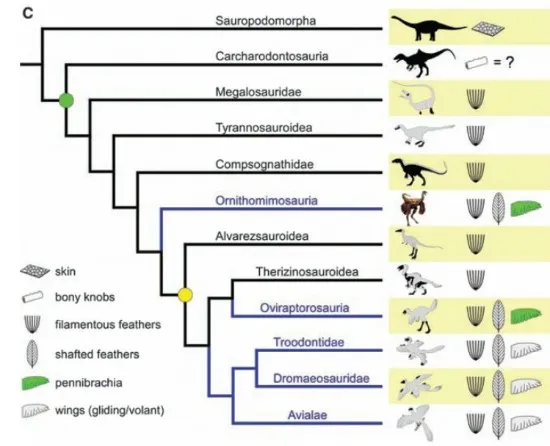Feathery Ostrich Mimics Enfluffle the Dinosaur Family Tree
A trio of feathered dinosaurs tests a longstanding hypothesis and hint that there may be more feathered dinosaur fossils than anyone ever expected
/https://tf-cmsv2-smithsonianmag-media.s3.amazonaws.com/filer/c2/c6/c2c66324-a863-4173-9f9c-0116a1be02e0/feathered-ornithomimus.jpg)
Another week, another feathery dinosaur. Since the discovery of the fluffy Sinosauropteryx in 1996, paleontologists have discovered direct evidence of fuzz, feather-like bristles and complex plumage on over two dozen dinosaur genera. I love it, and I’m especially excited about a discovery announced today. In the latest issue of Science, University of Calgary paleontologist Darla Zelenitsky adds another enfluffled species to the dinosaurian ranks. Even better, the specimens raise hopes that many more dinosaurs might be preserved with their feathery coats intact.
Zelenitsky’s downy dinosaurs are not newly discovered species. Ornithomimus edmontonicus was initially described by famed bone hunter C.H. Sternberg in 1933, and it is one of the characteristic Late Cretaceous species found in Alberta, Canada’s fossil-rich Horseshoe Canyon Formation. In Sternberg’s time, these dinosaurs were thought to be scaly, but recent finds of so many feathery dinosaurs has raised the likeliehood that the “ostrich mimic” dinosaur was at least coated in some sort of dinofuzz.

The prediction of fluffy Ornithomimus came from the spread of feathers on the coelurosaur family tree. The Coelurosauria is a major dinosaur group that encompasses tyrannosaurs, compsognathids, ornithomimosaurs, alvarezsaurs, oviraptorosaurs, deinonychosaurs and birds. To date, evidence of feathers has been found in every coelurosaur lineage except one–the ornithomimosaurs. The spread of feathers hinted that some sort of plumage was present in the common ancestor of all coelurosaurs and therefore should have been inherited by the ornithomimosaurs, but, until now, no one had found direct evidence.
A trio of Ornithomimus skeletons have finally confirmed what paleontologists expected. Zelenitsky enthusiastically explained the details to me by phone earlier this week. In 1995, when Zelenitsky was a graduate student, paleontologists uncovered an articulated Ornithomimus with weird marks on its forearms. No one knew what they were. But in 2008 and 2009 a juvenile and an adult Ornithomimus turned up with preserved tufts of filamentous feathers. “When we found these specimens,” Zelenitsky said, “we made the link to the 1995 dinosaur.” All those strange marks on the arms of the previously discovered Ornithomimus, Zelenitsky and colleagues argue, are traces of longer, shafted feathers.
Even though paleontologists expected feathery Ornithomimus, the discovery was still a surprise. “I was in disbelief,” Zelenitsky said. “They’re the first feathered dinosaurs from the Americas, and the first ornithomimosaurs with feathers, as well. It was shocking to say the least.”
But there’s more to the find than simply adding another species of fluffy dinosaurs to the list. The fact that the adult and juvenile animals had different kinds of plumage adds new evidence that coelurosaurs changed their fluffy coats as they aged. “The one juvenile was completely covered in filamentous type feathers,” Zelenitsky said. What the adults looked like comes from the two other specimens. One adult skeleton, lacking forearms, preserves fuzzy feathers, and “the second adult had markings on the forearm.” Together, the specimens indicate that adult Ornithomimus were mostly covered in fuzz but developed more complex arm feathers by adulthood.
Sex is probably behind the plumage change. “We infer that because these wing feathers are not showing up until later in life, they were used for reproductive purposes,” Zelenitsky said. Perhaps adult Ornithomimus used flashy arm feathers to strut their stuff in front of potential mates. Then again, based upon the resting and brooding postures of other theropod dinosaurs, adult Ornithomimus could have used their proto-wings to cover their nests. We don’t know for sure, but the developmental change appears to be another example of dinosaurs undergoing significant changes as they approach sexual maturity. This discovery, and others like it, will undoubtedly play into the ongoing discussion about the role of sexual selection in dinosaur biology and evolution.
Best of all, the new study indicates that paleontologists may soon find more feathered dinosaurs in unexpected places. The Ornithomimus skeletons were found in prehistoric river deposits composed of sandstone. Since almost all feathered non-avian dinosaurs have been found in fine-grained sediment–such as those around Liaoning, China–paleontologists thought that coarser-grained sandstone deposits were too rough to record such fine details. Now we know better. “That’s the really exciting part of it,” Zelenitsky says. If traces of dinosaur feathers can be preserved in sandstone, the twist opens up the possibility that paleontologists might find fluff and feathers with a greater array of dinosaurs–including the tyrannosaurs, deinonychosaurs, therizinosaurs and other coelurosaurs of North America. The trick is recognizing the traces before they’re destroyed during excavation and preparation. Rock saws and airscribes can all too easily obliterate the delicate fossils. A word to researchers–keep your excavation tools sharp, and your eyes sharper.
Reference:
Zelenitsky, D., Therrien, F., Erickson, G., DeBuhr, C., Kobayashi, Y., Eberth, D., Hadfield, F. 2012. Feathered non-avian dinosaurs from North American provide insight into wing origins. Science. 338, 510-514
/https://tf-cmsv2-smithsonianmag-media.s3.amazonaws.com/accounts/headshot/RileyBlack.png)
/https://tf-cmsv2-smithsonianmag-media.s3.amazonaws.com/accounts/headshot/RileyBlack.png)